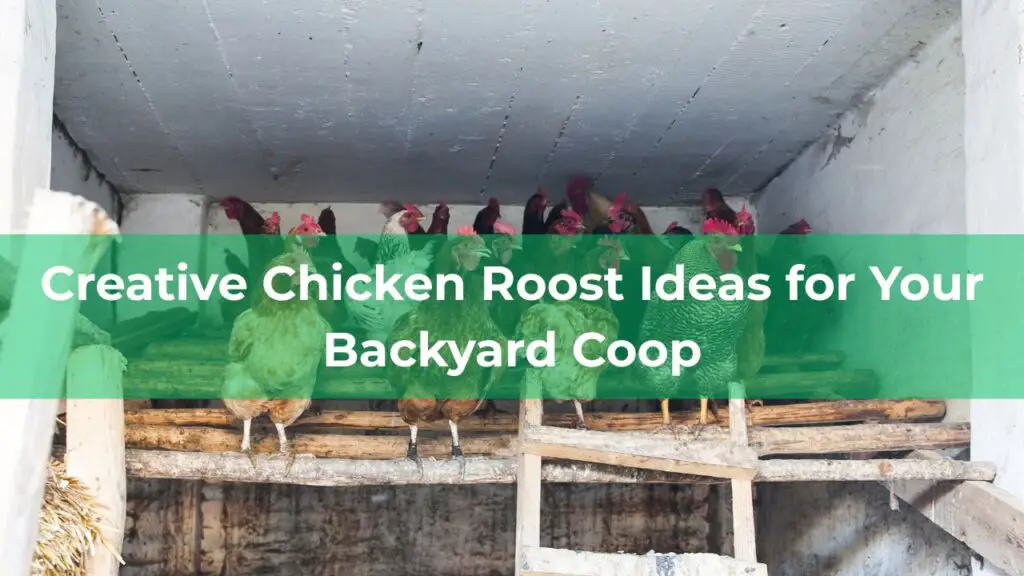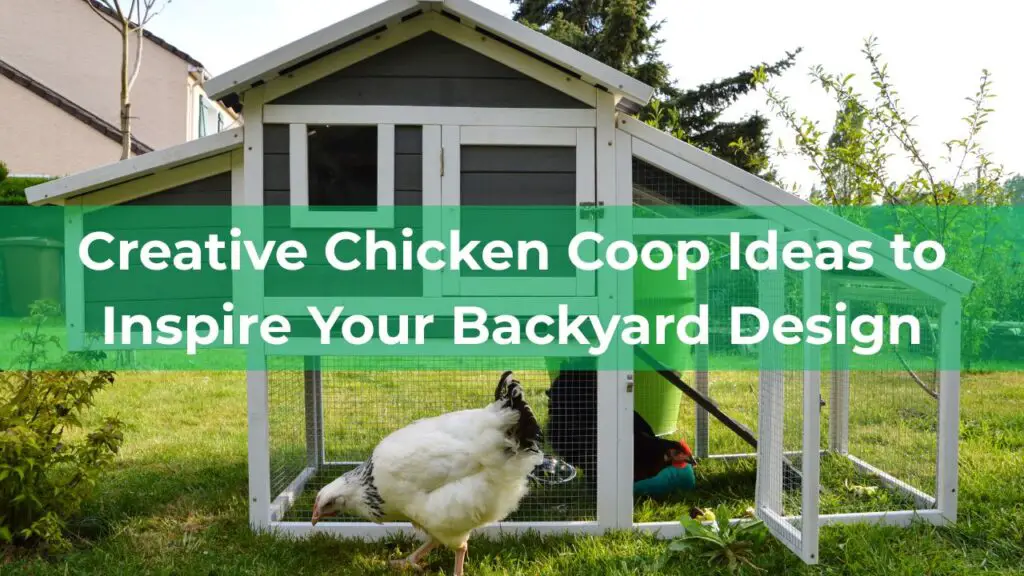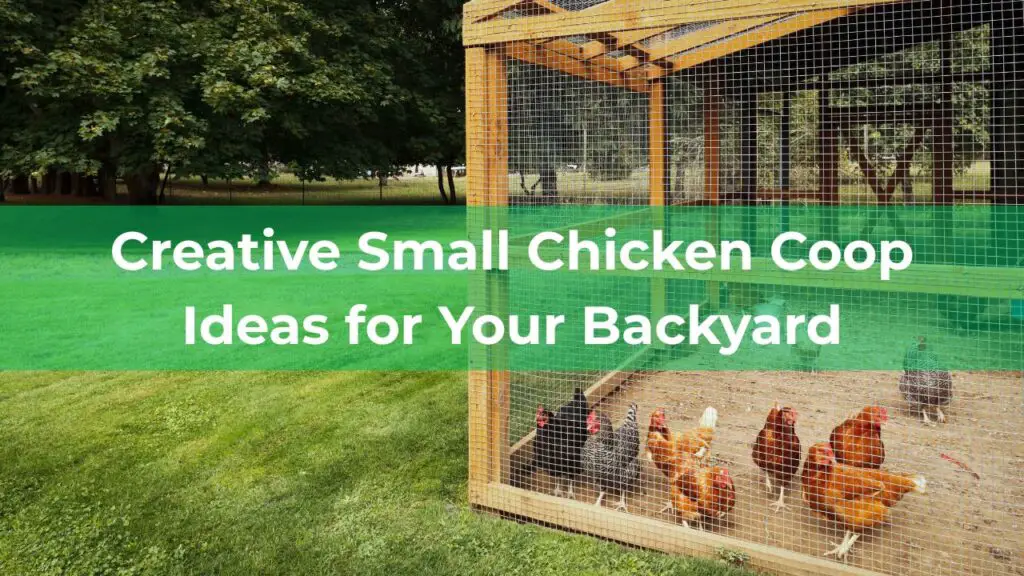Disclosure!
At The Daily Farming, your trust means everything. We use AI to help create some of our content, but every post is carefully reviewed and edited by real humans before it’s published.
Some of our images are AI-generated to help illustrate ideas, but everything you see is checked and approved by us.
Thanks for being here—we’re grateful for you!
Finding the perfect chicken roost can be a fun and creative endeavor! Whether you’re looking to build a cozy space for your feathered friends or just want to spruce up their environment, there’s plenty of inspiration to spark your imagination. From crafty DIY ideas to practical setups, let’s explore some exciting options for a happy, healthy chicken roost.
Key Factors to Consider Before Building or Buying a Chicken Roost
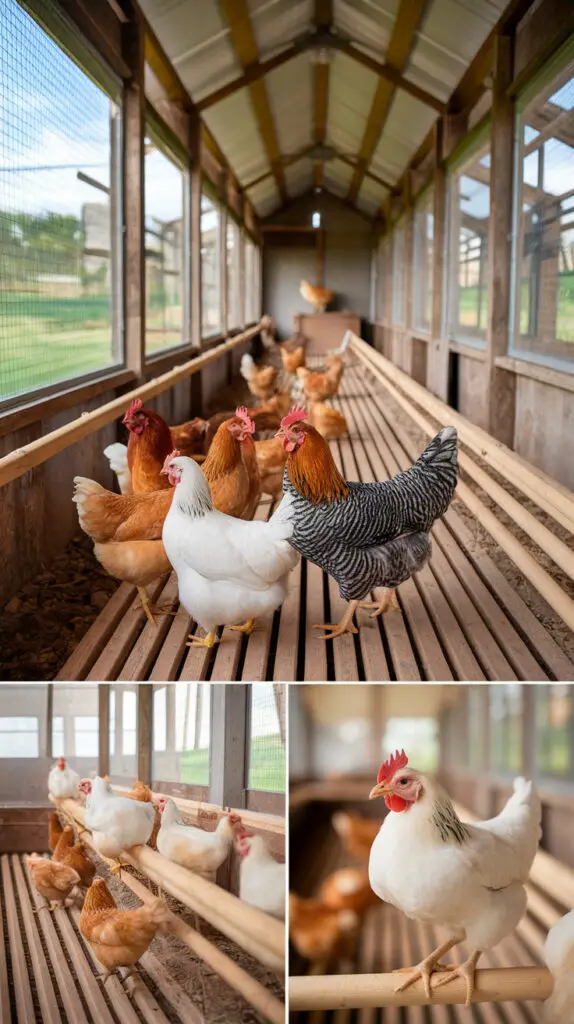
Before you grab your hammer or hit “buy now,” take a second. A chicken roost isn’t just a wooden stick you throw into the coop. It’s your chickens’ bed. Their chill-out zone. Their safe place when the sun goes down.
So yeah—it’s kind of a big deal.
Here’s what you should think about before you get started:
How Many Chickens Do You Have?
This one’s huge. Chickens need personal space when they sleep. They’re social creatures, sure—but even chickens don’t want to cuddle all night long.
Plan for 8 to 12 inches of roosting space per bird. Got 10 chickens? You’ll need at least 8–10 feet of total roost bar. And a little extra never hurts, especially if someone in the flock’s a drama queen and likes to peck at her neighbors.
Breed and Size of Your Chickens
Not all chickens are created equal.
Big girls like Brahmas or Orpingtons? They need sturdier, wider roosts. Something with a little more surface area to support their fluffy bodies. Think 2x4s laid flat.
Tiny bantams? They’re light on their feet and can perch on narrower bars or even thick branches.
Point is—know your chickens. What works for a Silkie won’t work for a Jersey Giant.
Coop Size and Layout
Before you start building a roost the size of a jungle gym, take a peek around your coop.
Got space? Great—go wild with multi-tiered roosts or a fancy corner ladder.
Tight quarters? No problem. A single, well-placed bar or a fold-up design can still give your girls the perch they need.
Just make sure they’ve got enough headroom to hop up without bashing their brains on the ceiling. No one wants a concussion at bedtime.
Climate and Ventilation
Hot summers? Cold winters? Drafty barn?
The weather matters.
In colder areas, chickens fluff up to stay warm—so make sure your roost isn’t right next to a drafty window. Too much wind = cold chickens = frostbitten combs. Not fun.
On the flip side, in hot places, airflow is everything. You want your birds to catch a breeze, but not be in the path of a cold blast at night.
Balance is key. Keep things breezy, not blustery.
Predator Safety
It’s not just about comfort—it’s about survival.
Your roost should be high enough that raccoons, rats, and snakes can’t grab an easy chicken dinner. Inside the coop is best. And if it’s outside? Make sure the whole setup is locked down tighter than Fort Knox.
Also: no low roosts near the coop door. That’s like sleeping with your feet hanging out of the blanket—tempting fate.
Cleaning and Maintenance
Last but not least—you matter too.
Can you reach the roosts easily to clean them? Are they removable? Can you scrape off poop without pulling a muscle?
Consider adding a droppings board underneath to catch the mess and save yourself the daily deep-clean.
The cleaner your roosts, the healthier your flock—and the less gross your mornings will be.
Ideal Dimensions for Chicken Roosts
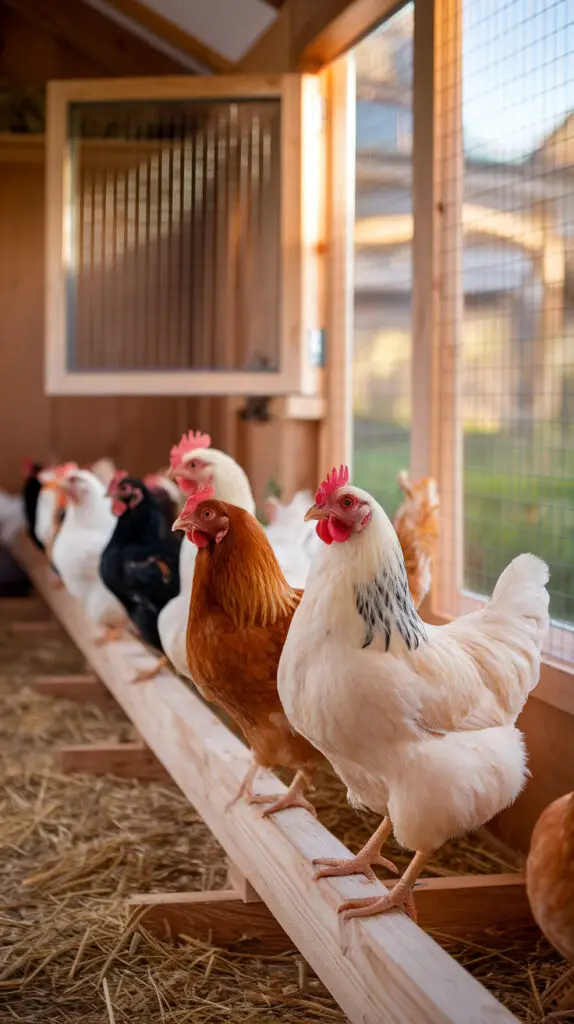
Alright—let’s talk numbers. Because when it comes to chicken roosts, size does matter.
Give your hens a perch that’s too narrow, too close to the floor, or way too crowded… and you’ll have cranky birds, messy feathers, and maybe even a few fights at bedtime.
Here’s what you need to know to get it right:
Recommended Height Off the Ground
Chickens like to sleep off the ground. It makes them feel safe. Protected. Queen-of-the-hill style.
But how high is too high?
A good rule: start at 18 inches to 2 feet off the coop floor.
Lighter birds can go higher—3 or 4 feet is fine. Just make sure there’s a way up, like a ramp or lower step, especially for heavier girls who aren’t exactly graceful flyers.
For big breeds like Orpingtons or Brahmas? Keep it closer to 18–24 inches. Trust me—those fluffy butts don’t like climbing.
Width and Length of Perches
Chickens don’t grip like songbirds. They rest on their feet. That means they need a flat(ish) surface—not a skinny pole.
The magic number?
Use a 2×4 board, laid flat (wide side up). It gives their feet full contact and helps keep toes warm in winter. No frostbite here!
As for length—just do the math.
Each hen needs 8 to 12 inches of space. Multiply that by your flock size, and you’ve got your perch length.
Got 8 chickens? Shoot for at least 6–8 feet total.
More is always better—especially if your flock has a pecking order (and trust me, they all do).
Spacing Between Roost Bars
If you’re going for multiple bars—like in a ladder-style roost—space them out!
You don’t want birds pooping on each other (gross), or bumping heads trying to get comfy.
Aim for at least 12 to 18 inches of vertical space between each level.
And leave 12–16 inches between bars horizontally, too. This gives them room to flap, jump, and spread their wings a bit.
Think roomy bunk beds. Not a chicken subway at rush hour.
How Much Roost Space Per Chicken?
This one’s easy: 8 to 12 inches per hen.
If your flock is chill and they like to snuggle, you can get away with the lower end. But if you’ve got some divas in the mix? Give them space to stretch out and avoid the drama.
And don’t forget—add a little extra. Chickens are picky, and someone always wants their own corner.
Chicken Roost Ideas to Inspire You
Ready to get creative? Whether you’re building from scratch or just giving your coop a little upgrade, there are tons of ways to design a roost your chickens will love. From simple wooden bars to clever DIY setups using stuff you’ve already got in the garage—there’s no one “right” way to do it.
Here are some chicken roost ideas to spark your imagination and keep your flock cozy, clean, and content.
Basic Single Bar Roost
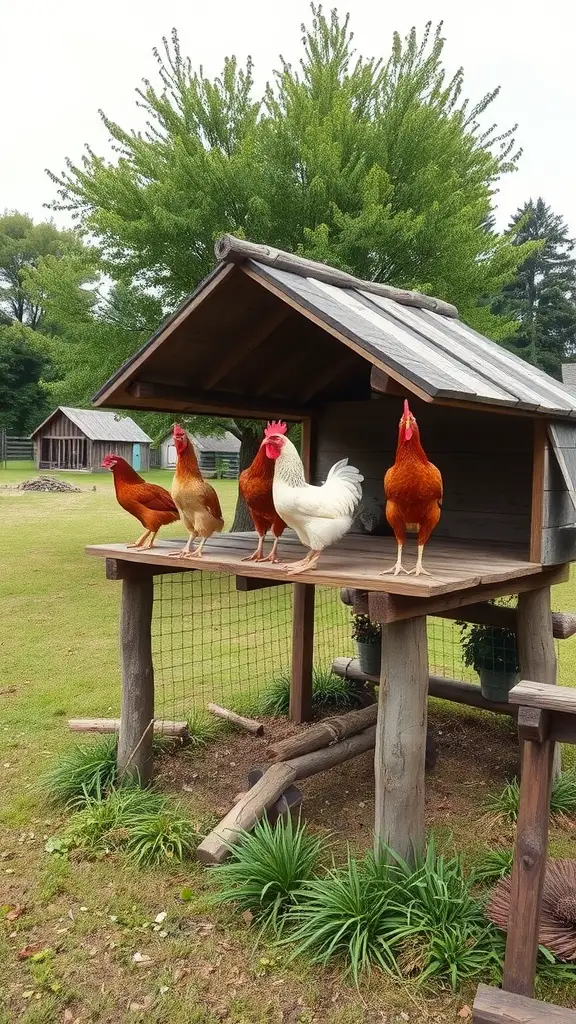
This simple design is perfect for backyard poultry owners looking for a straightforward solution for their feathered friends. The roost is sturdy and elevated, giving the chickens a safe place to perch.
The vibrant colors of the chickens add a lively touch to the scene. Roosting bars are important for chickens as they provide comfort and security while they sleep. Keeping them off the ground helps deter pests and creates a cozy resting spot.
In this setup, you can see four chickens happily lined up on the bar. The design allows ample space for them to spread out, reducing squabbles and ensuring that each bird has a place to roost. A single bar is easy to clean and maintain, making it a practical choice for many chicken keepers.
Ladder-Style Chicken Roost
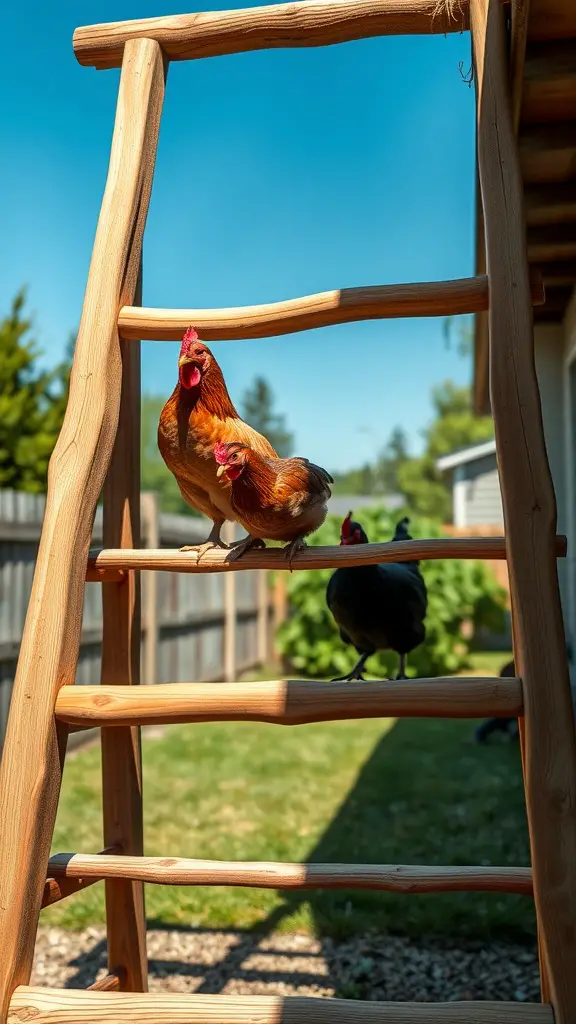
A ladder-style chicken roost is a unique and space-saving solution for your feathered friends. This design allows chickens to perch at different heights, mimicking their natural behavior of roosting in trees.
The ladder not only looks inviting but also provides a cozy spot for the chickens to rest and socialize. It adds a rustic charm to your coop and can be easily customized to fit your space.
When building your own ladder-style roost, consider the materials. A sturdy wood, like cedar or pine, works well and is safe for chickens. Make sure the rungs are spaced appropriately for their size, allowing them to hop up and down easily.
This type of roost can be a fun DIY project, enhancing your chicken coop’s overall design. Plus, it encourages healthy behaviors by giving chickens a chance to exercise while they climb up and down!
Wall-Mounted Roosts
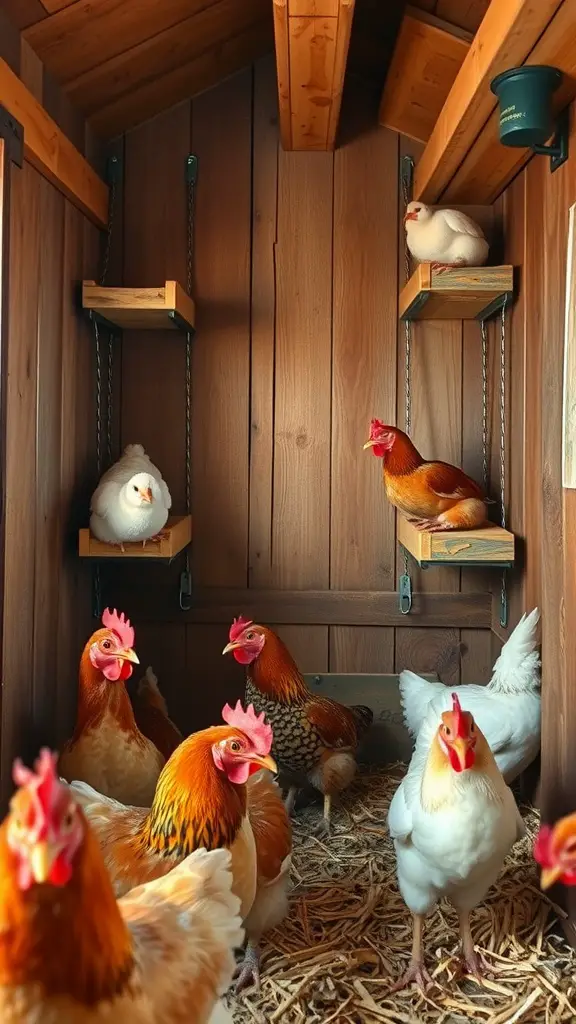
Wall-mounted roosts make fantastic use of space in your chicken coop. They can keep your chickens off the ground and provide a cozy place for them to rest. In this image, you can see a well-designed roost setup that allows several chickens to perch comfortably.
These roosts are ideal for smaller coops where floor space is limited. You can simply attach wooden shelves to the walls, creating multiple levels for your chickens to choose from. The height is important; chickens feel safer when they can perch higher up.
Notice how the roosts are sturdy and have adequate support. Properly installed roosts ensure that your chickens can hop up and down easily without any risk of injury. Plus, they create a charming look in the coop.
Overall, wall-mounted roosts not only save space but also enhance the comfort of your chickens. They’ll love having their own special spots to relax and sleep at night!
Freestanding Roost Frames
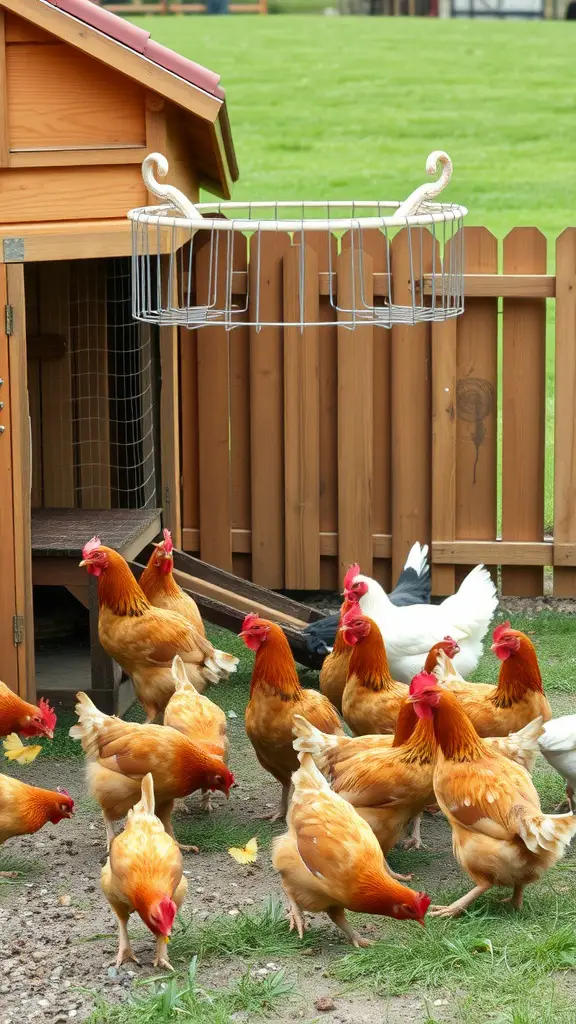
Freestanding roost frames are a great way to give your chickens a cozy place to perch. These frames can be set up anywhere in your yard, making them flexible and convenient. You can choose from various designs that fit well with your existing chicken coop or run.
The frame appears sturdy and well-placed, allowing the chickens to safely enjoy their time outdoors. Chickens love to be off the ground, and having a dedicated roost can keep them happy and healthy.
When deciding on a roost design, think about the number of chickens you have and their sizes. It’s essential to ensure the roost is high enough for your birds to have a comfortable view, but not so high that they might hurt themselves jumping down. This balances safety and enjoyment.
Building your own roost is another fun project! You can use reclaimed wood or purchase supplies from your local hardware store. Adding some fun touches, like a painted finish or decorative elements, can make it an attractive addition to your yard.
Corner Roost Designs
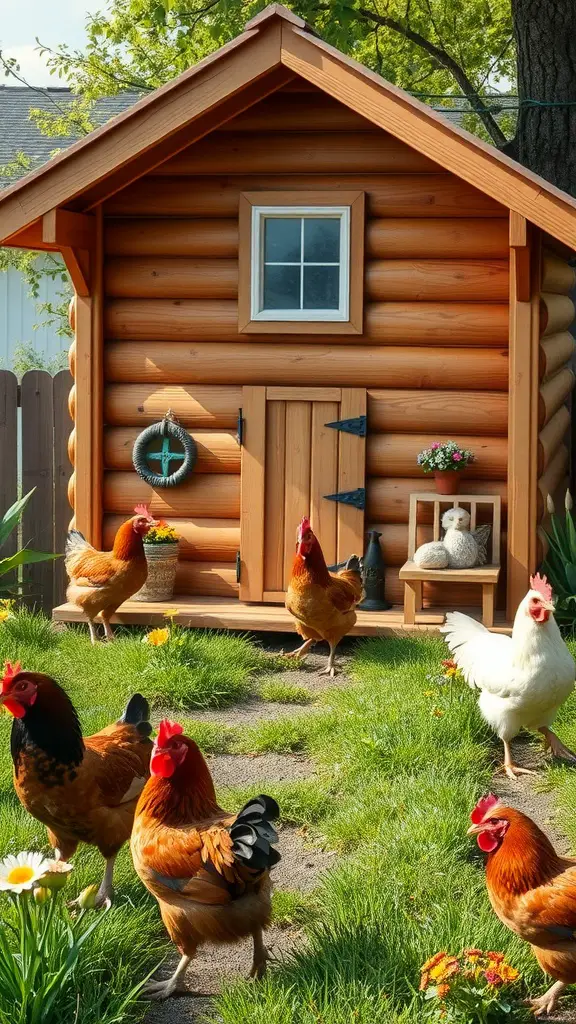
When planning a cozy spot for your chickens, corner roost designs can be a great option. These designs maximize space while providing a safe and comfortable area for your feathered friends. You can easily integrate a corner roost into your chicken coop, making the most of every inch.
The natural wood finish adds character, while the small porch area creates a welcoming vibe. Friendly chickens roam around the lush green grass, showing how vital it is for them to have space to explore.
Incorporating corner roosts allows chickens to utilize vertical space. Placing roosts higher up encourages chickens to feel secure, as they can avoid any ground-level disturbances. A solid roost made of sturdy materials like wood can provide comfort and stability.
It’s important to keep the roosts clean and accessible. Regular maintenance will ensure your chickens remain healthy and happy. With a well-thought-out corner roost design, your backyard can turn into a perfect retreat for your chickens, blending functionality with style.
Tree Branch Roosts (Natural Look)
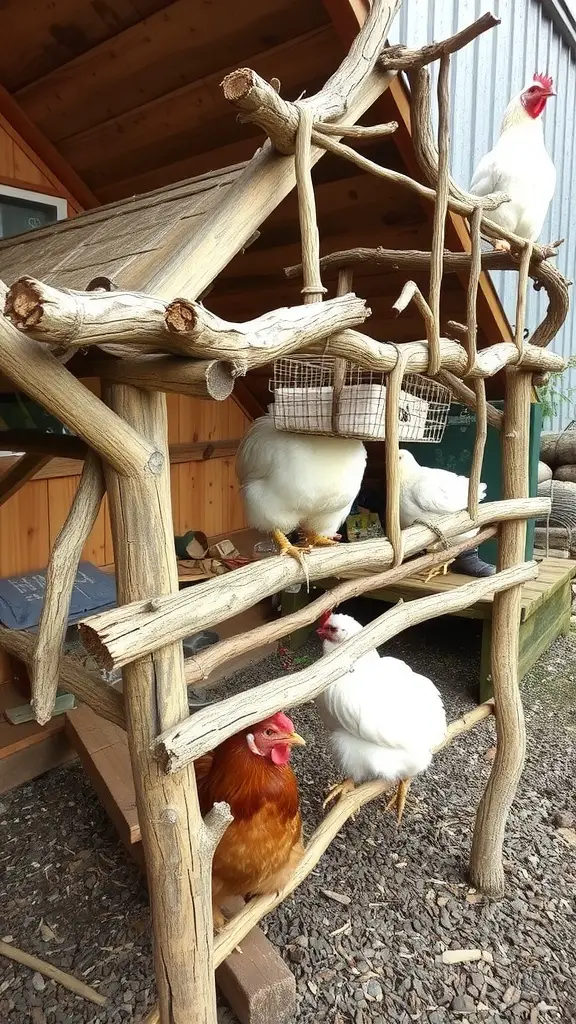
Tree branch roosts offer a fun and natural touch to your chicken coop. They’re not just functional but also add an appealing aesthetic to your yard. The image shows a creative setup with branches forming a unique roosting structure, allowing chickens to feel relaxed and safe.
Chickens love to perch at different heights. The branches in the image provide various levels for them to choose from, promoting their natural behaviors. This type of roosting can keep them entertained and happy while also giving them a sense of security.
A natural look can blend seamlessly into your garden. Using branches from your yard or local area gives the roost an organic feel. It makes the chickens feel more at home and also enhances the beauty of your space.
When building a tree branch roost, ensure the branches are sturdy and spaced well apart. This way, your chickens can easily jump from one branch to another. It’s a simple project that can yield big benefits for both you and your feathered friends!
Foldable Or Removable Roost Bars
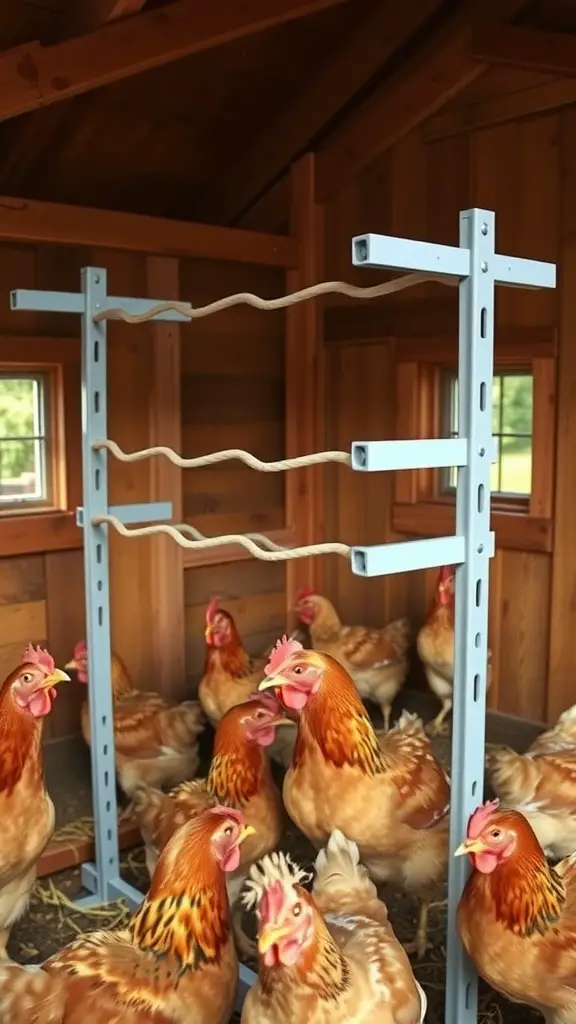
When setting up a cozy home for your chickens, foldable or removable roost bars can be a fantastic choice. They provide flexibility and convenience, making it easy to adjust the layout of your coop. In the image, you can see a neat setup of roost bars designed for easy use.
These bars allow chickens to perch comfortably while also making cleaning much simpler. You can remove them when needed, ensuring that the coop stays tidy and hygienic. Plus, foldable designs save space, which is always a win.
Another great aspect of these roost bars is that they can be adjusted to fit the needs of your flock. Whether you have younger birds or fully grown hens, you can set the height just right for them. This thoughtful design contributes to happier and healthier chickens.
So, if you’re looking for a practical solution for your chicken roosting needs, consider foldable or removable options. They not only optimize comfort for your birds but also make maintaining their space a breeze.
Pvc Or Metal Roosts (For Easy Sanitizing)
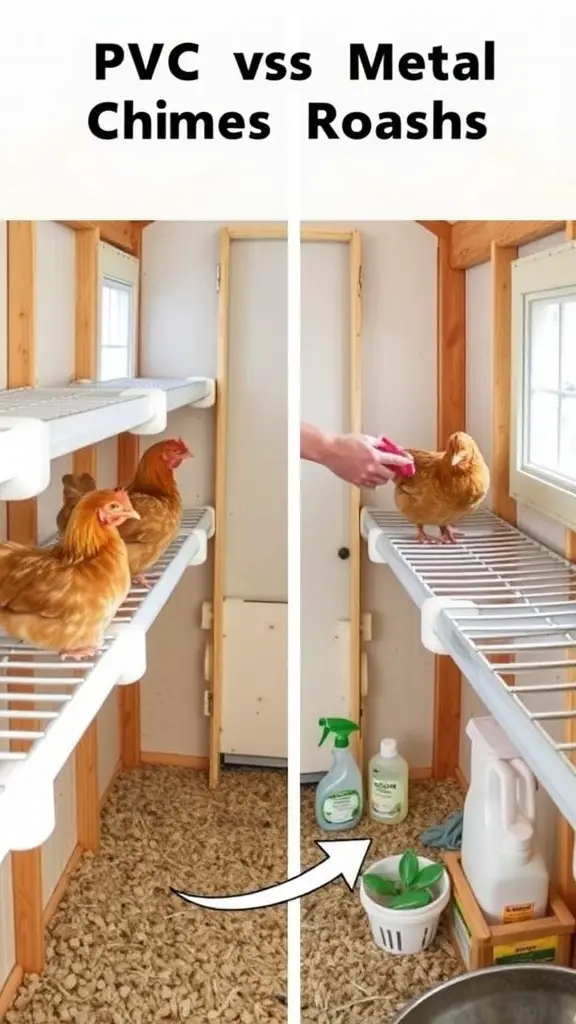
When thinking about chicken roosts, materials like PVC or metal stand out for their ease of cleaning. The image shows two setups: one with a sleek PVC roost and another with a metal design. Both options make sanitation a breeze, which is crucial for keeping your chickens healthy.
The PVC roost is practical and lightweight. It won’t absorb moisture or bacteria, making it easy to wipe down. On the other hand, the metal roost is sturdy and durable. It can handle the wear and tear of a busy chicken coop while still being simple to sanitize. Both choices help promote a clean environment for your feathered friends.
Sanitizing is more than just a chore; it’s essential for preventing disease. Using these materials means you can keep your roost clean with minimal effort. A quick scrub with some disinfectant, and you’re all set!
Choosing between PVC and metal often comes down to personal preference and coop design. Either way, your chickens will appreciate a clean place to perch.
Multi-Tiered Chicken Roosting Structures
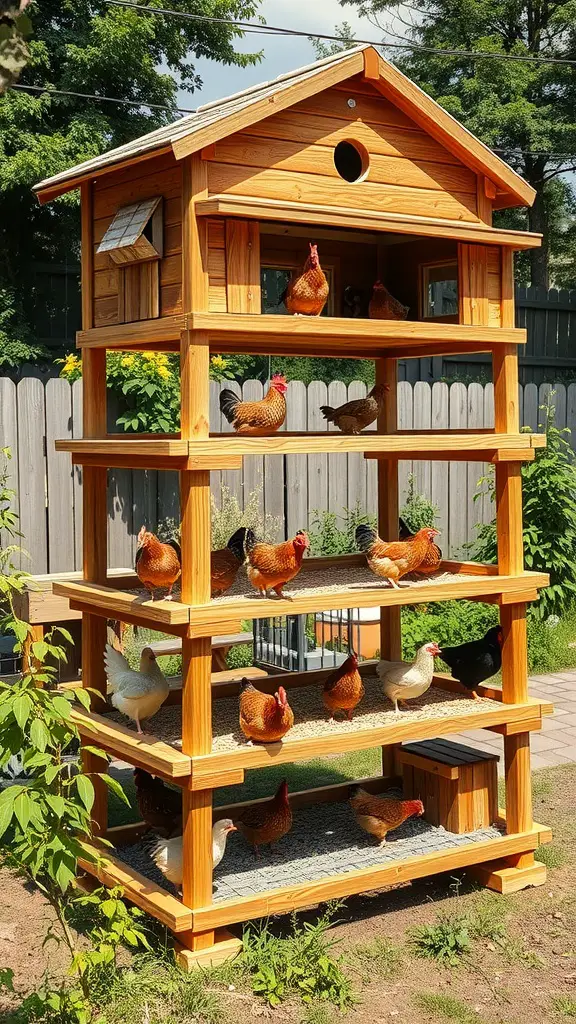
Multi-tiered chicken roosting structures are a fantastic way to maximize space while keeping your flock comfortable. The image shows a beautifully crafted multi-level roost where chickens can choose their favorite spot to settle down for the night.
This design not only looks great but also encourages social interaction among your chickens. Each tier offers a different vantage point, allowing them to engage with one another while still having their own space. You’ll notice various breeds happily perched on the different levels, making it a lively scene.
When thinking about building or buying a roosting structure, consider the materials used. The wooden design in the image is not only sturdy but can also be treated to withstand the elements. This allows your chickens to enjoy their roost in any weather.
Multi-tiered systems can also be easier to clean. With accessible shelves, you can quickly remove droppings and maintain a tidy coop. Plus, it can reduce the overall footprint in your yard, making it a smart choice for those with limited space.
FAQs
Got questions? Totally normal. Roosts might seem basic, but there’s more to them than meets the eye. Let’s tackle some of the most common ones:
How high should chicken roosts be?
It depends on your flock.
For most standard breeds, anywhere from 18 inches to 3 feet off the ground is perfect. Big, heavy chickens like Orpingtons or Brahmas? Stick to the lower end—they’re not exactly Olympic jumpers.
Lighter birds, like Leghorns, love to fly up higher. Just make sure they have space to land safely and aren’t crashing into walls or each other.
Also, don’t forget to give them a little step or ramp if the roost is really high. Chickens aren’t fans of bungee jumping.
Can chickens share roost bars?
Absolutely—and they will. Chickens are flock animals. They like to snuggle up when they sleep, especially in colder weather.
Just make sure they have enough space. Aim for 8 to 12 inches per bird. Too little space, and things can get tense. (Ever seen a chicken squabble at bedtime? Feathers fly.)
So yes, sharing is fine. Just give them room to choose who they want to sleep next to.
What’s the best material for chicken roosts?
Plain, unfinished wood is your best bet. It’s easy for chickens to grip with their feet, it’s safe, and it feels natural.
Avoid metal—it can get freezing cold in winter and burn hot in summer. PVC? Meh. It’s too slippery.
Wood 2x4s, natural branches, or even old wooden broom handles work great—as long as they’re strong, clean, and splinter-free.
Should roosts be flat or round?
Here’s the deal: Flat is usually better—especially in colder climates.
A 2×4 laid flat gives chickens a nice wide surface to perch on, which lets them cover their toes with their feathers at night. That keeps them warmer and helps prevent frostbite.
Round bars (like a broomstick) can work for smaller breeds or warmer areas, but wide and flat is the safest all-around choice.
Do baby chicks need a roost?
Not right away—but they’ll start trying to use one sooner than you’d think.
By around 3 to 4 weeks old, chicks begin hopping up on anything they can—feeder edges, waterers, your hand. That’s your cue.
Add a low, small roost (just a few inches off the ground) to their brooder so they can start practicing. It’s not essential, but it helps them develop balance and coordination early on.
And honestly—it’s adorable to watch.
Can I use a tree branch as a chicken roost?
Yes, and chickens love it!
Tree branches make great roosts as long as they’re thick, sturdy, and clean. Look for a branch about 2–3 inches in diameter, and try to smooth out any sharp bits or peeling bark.
Bonus? It gives the coop a natural, rustic vibe—and it’s totally free if you’ve got a decent tree nearby.
Just be sure it’s not from a toxic tree (like black walnut or yew). Safety first.

